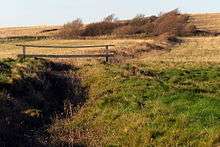Culverwell Mesolithic Site
Culverwell Mesolithic Site is a Mesolithic settlement, located on the Isle of Portland, Dorset, England. It is found in the local area known as Culverwell, along the Portland Bill Road.[1] It is within an area of unspoiled countryside, with no past quarrying.[2][3] The site is maintained by the Association for Portland Archaeology – a small group dedicated to researching, investigating and excavating on Portland.[4]
Open days have been held on the site, where guided tours take place of the preserved site, showing and explaining the visible remains and artefacts and how Mesolithic people lived.[5] In 2004, the Culverwell Mesolithic Site won an archaeological award; the prestigious "Pitt Rivers Award", for developing this Mesolithic site on Portland.[6]
The surrounding fields between the Bill and Southwell are made up of an ancient strip field system, once found all over the island before quarrying continued to destroy them. These particular fields remain untouched from housing or quarrying. Culverwell Mesolithic Site has become a scheduled monument under the Ancient Monuments and Archaeological Areas Act 1979 as it appears to the Secretary of State to be of national importance.[7]
Background

The site is said to be circa 7500-8500 years old. The site's main feature is the large floor of limestone slabs on top of a shell midden (rubbish dump). The floor is unique for this period and is also the earliest known structural evidence in England for the extensive use of Portland Jurassic limestone on a living site. Other features on the site include the remains of a low wall, four hearths, a cooking pit. A ritual feature incorporated into the floor consisted of a sub-triangular stone with a large beach cobble next to it. Vast quantities of stone tools and the debris created during their production have been found on the site. The most common tools are microliths, scrapers, knives, chopping tools, pounders and picks. Pierced shell beads have also been found.
Some academics estimate that the total Mesolithic population of Britain never exceeded 5000, and it is likely that approximately 20 people lived on the site for at least 20-25 years in 4-5 stone huts. The occupants were possible semi-sedentary, and survived by gathering molluscs and edible plants with the addition of occasional meat. Water came from the nearby Culver Well, and the chert for the stone artefacts came from exposures in the cliffs. The edge of the sea was about 300–400 metres further out than it is presently.[5] In November 1999, Archaeopress published the book Culverwell Mesolithic Habitation Site: Excavation Report and Research Studies, written by Susann Palmer. The book is part of the British Archaeological Reports (BAR).[8]
References
- ↑ "Pictures- Portland, Dorset". Weymouth-pictures.co.uk. Retrieved 11 July 2013.
- ↑ "Culverwell, Portland, Dorset". Geoffkirby.co.uk. Retrieved 11 July 2013.
- ↑ "Contributions to the Mesolithic in Europe: Papers Presented at the Fourth ... - Pierre M. Vermeersch - Google Books". Books.google.co.uk. Retrieved 11 July 2013.
- ↑ "Association for Portland Archaeology - Home". Portlandarchaeology.weebly.com. Retrieved 11 July 2013.
- 1 2 "Culverwell Mesolithic Site | UK". The Modern Antiquarian.com. Retrieved 11 July 2013.
- ↑ The Megalithic Portal and Megalith Map. "Culverwell Mesolithic Site Ancient Village or Settlement : The Megalithic Portal and Megalith Map:". Megalithic.co.uk. Retrieved 11 July 2013.
- ↑ Historic England. "Details from listed building database (1002406)". National Heritage List for England. Retrieved 28 September 2015.
- ↑ "Culverwell Mesolithic Habitation Site, Isle of Portland, Dorset: Excavation Report and Research Studies British Archaeological Reports BAR British: Amazon.co.uk: Susann Palmer: Books". Amazon.co.uk. 19 November 1999. Retrieved 11 July 2013.
Coordinates: 50°31′24″N 2°26′44″W / 50.5232°N 2.4455°W
